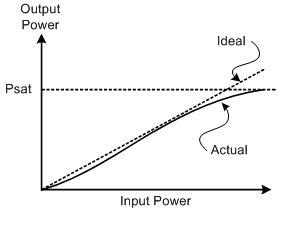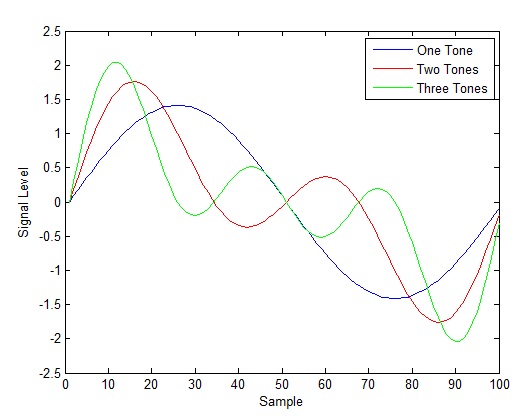Peak to Average Power Ratio (PAPR) as the name suggests is the ratio of peak signal power to the average signal power and has received considerable attention in the context of multicarrier signals like OFDM which exhibit a high PAPR. The down side of this high PAPR is that the power amplifier in the transmitter is operated at a relatively lower power level so that the peaks in the signal are not distorted by the saturating amplifier. This is called the amplifier backoff and it plays an important part in wireless system design.
The reason for this high PAPR is that when multiple sinusoids are added together in a multicarrier transmission the resulting signal exhibits constructive and destructive behavior. The higher the number of these sinusoids higher is the PAPR. The following example illustrates this behavior.
It is observed that the PAPR of a signal composed of two sinusoids is greater than that of a single sinusoid. Similarly the PAPR of a signal composed of three carriers is even higher. The PAPR for the case of a single tone, two tones and three tones is 2.00, 3.10 and 4.15 respectively. Or on a logarithmic scale 3.01 dB, 4.91 dB and 6.18 dB respectively. So if the power amplifier in a wireless system starts saturating at 24 dBm then the average signal power of three tone system must not exceed 24-6.18=17.82 dBm. In practical systems techniques are adopted that decrease the PAPR so that the power amplifier can operate close to its maximum limit. One simple technique clips the peaks in the signal, while another adds tones at the unused frequencies such that the total PAPR is reduced.
Note:
1. The three tones in the above example are at ‘f’, ‘2f’ and ‘3f’ Hz.
2. Another metric that we will discuss in a future post is the cubic metric (CM).
Author: Yasir
More than 20 years of experience in various organizations in Pakistan, the USA, and Europe. Worked with the Mobile and Portable Radio Group (MPRG) of Virginia Tech and Qualcomm USA and was one of the first researchers to propose Space Time Block Codes for eight transmit antennas. Have publsihed a book “Recipes for Communication and Signal Processing” through Springer Nature.


One thought on “Peak to Average Power Ratio (PAPR)”
congratulations on making a half century.